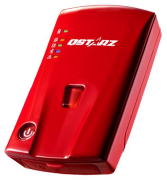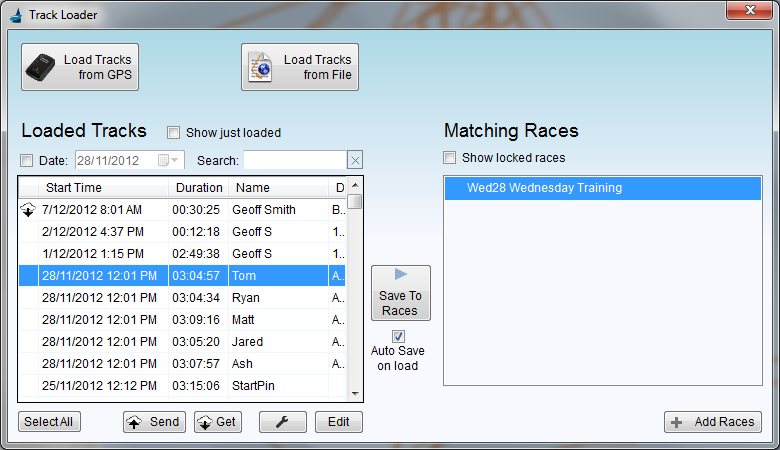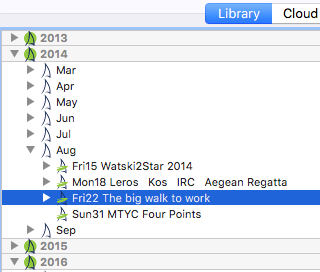Logged Tracking
Logged Tracking is the simple and low-cost way to track your racing. Once you have purchased your Logged Tracking license and GPS loggers there are no ongoing costs for tracking. Races can be freely published to the TackTracker Cloud.
A GPS Logger records regular time-stamped location data to its internal memory and this data is directly uploaded via a USB cable into your computer after the race or training session.

For supported devices, such as the QStarz BL-1000ST pictured, TackTracker makes this process as fast and simple as possible by directly loading the data from the device into TackTracker, without the need for any intermediate utility programs.
GPS loggers are very simple to setup and use. There are only two buttons on the QStarz loggers - the power button and a "Point of Interest" (POI) button, which creates a numbered point on your track.
Getting Started
To get started with GPS logging you will need one or more QStarz BT-Q1000XT or BL-1000ST GPS loggers with water proof pouches and a TackTracker Logged Tracking license. Get in touch with us and we'll be happy to learn your requirements and provide a quotation.
Logged Tracking License
Logged Tracking requires the TackTracker Windows desktop application available from our download page. You also need a Logged Tracking license, which you may purchase from the TackTracker Shop.
The Logged Tracking License unlocks the following features needed for logged tracking:
- The Track Loader - which can load tracks from a file, a QStarz GPS or even the TackTracker Cloud. The Track Loader lets you manage loaded tracks, and is integrated with the Race Editor so you can easily create a race including a selected set of tracks.
- The Race Library - a chronological archive of all your races. The Race Editor is used to save races to your Track Library.
The Track Loader 
The Track Loader is the place to go to load tracks into TackTracker, from any source including direct from a GPS Logger, from a GPS file (such as a GPX or NMEA file) or the TackTracker Cloud. All tracks go into the Track Loader's "Loaded Tracks" area. From there you can view and edit tracks, add them to races or invoke the Race Editor to create new races.
You can also send tracks to the TackTracker Cloud to share them with other people.

The Track Loader has built-in drivers for QStarz Loggers and can load tracks from a connected logger directly into TackTracker:
Note that the boat or skipper name and details can be stored in the logger memory, so you don't need to key it in each time. You can also configure the tracking interval. A 1 second interval is best for training and tacking analysis, 2 seconds is ideal for general small boat racing and longer intervals are appropriate for larger boats and long races. If short tracking intervals are important to you, logged tracking is the preferred option, as current live trackers do not typically go below 5 seconds per update.
The Race Library
The Race Library is a complete record of all your racing. Races are archived chronologically by year, month and day. Click on any race to play it. The Library is also the place to go to publish your race to your home page on the TackTracker Cloud. Just right click on any race and the use the pop-up menu to accomplish your task.

Share Tracks with the TackTracker Cloud
TackTracker makes tracking simple - whether it be a weekend race or a regatta. If you're using logging trackers, the TackTracker Cloud makes it no longer necessary to manage trackers centrally. No longer is it necessary need to spend time collecting trackers after each race session and loading them up at a central point.
Instead, each competitor can manage their own tracker, and the TackTracker Cloud will bring the tracks together - automatically!
Consider an example: Peter and Josh each have a tracker and after the race, sent their own tracks to the TackTracker cloud. All they needed to do was load their track and click "Send". A little bit later, when Sally comes to publish the race, she can get Peter and Josh's tracks automatically from the cloud into her race.
Sally then publishes the race and it is immediately available for all to review. However, John has not yet sent his track, but when he does later that night, the Cloud automatically matches it to the race and merges in John's track. Everyone can now view the race with John's track included.
And what about Roger who used a live tracker in the same race? Well, his track is included too as it was being uploaded to the cloud as he sailed the race.